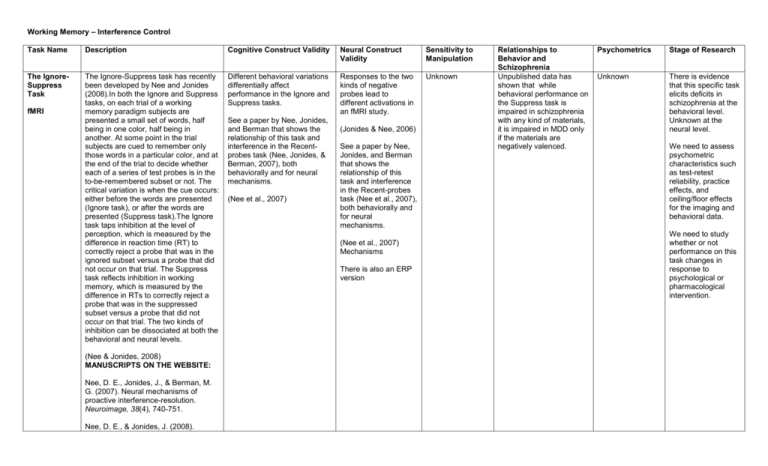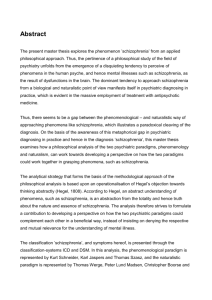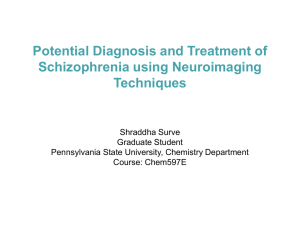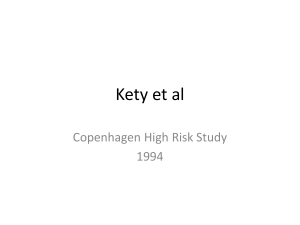Perception – Gain Control
advertisement

Working Memory – Interference Control Task Name Description Cognitive Construct Validity Neural Construct Validity Sensitivity to Manipulation The IgnoreSuppress Task The Ignore-Suppress task has recently been developed by Nee and Jonides (2008).In both the Ignore and Suppress tasks, on each trial of a working memory paradigm subjects are presented a small set of words, half being in one color, half being in another. At some point in the trial subjects are cued to remember only those words in a particular color, and at the end of the trial to decide whether each of a series of test probes is in the to-be-remembered subset or not. The critical variation is when the cue occurs: either before the words are presented (Ignore task), or after the words are presented (Suppress task).The Ignore task taps inhibition at the level of perception, which is measured by the difference in reaction time (RT) to correctly reject a probe that was in the ignored subset versus a probe that did not occur on that trial. The Suppress task reflects inhibition in working memory, which is measured by the difference in RTs to correctly reject a probe that was in the suppressed subset versus a probe that did not occur on that trial. The two kinds of inhibition can be dissociated at both the behavioral and neural levels. Different behavioral variations differentially affect performance in the Ignore and Suppress tasks. Responses to the two kinds of negative probes lead to different activations in an fMRI study. Unknown fMRI (Nee & Jonides, 2008) MANUSCRIPTS ON THE WEBSITE: Nee, D. E., Jonides, J., & Berman, M. G. (2007). Neural mechanisms of proactive interference-resolution. Neuroimage, 38(4), 740-751. Nee, D. E., & Jonides, J. (2008). See a paper by Nee, Jonides, and Berman that shows the relationship of this task and interference in the Recentprobes task (Nee, Jonides, & Berman, 2007), both behaviorally and for neural mechanisms. (Nee et al., 2007) (Jonides & Nee, 2006) See a paper by Nee, Jonides, and Berman that shows the relationship of this task and interference in the Recent-probes task (Nee et al., 2007), both behaviorally and for neural mechanisms. (Nee et al., 2007) Mechanisms There is also an ERP version Relationships to Behavior and Schizophrenia Unpublished data has shown that while behavioral performance on the Suppress task is impaired in schizophrenia with any kind of materials, it is impaired in MDD only if the materials are negatively valenced. Psychometrics Stage of Research Unknown There is evidence that this specific task elicits deficits in schizophrenia at the behavioral level. Unknown at the neural level. We need to assess psychometric characteristics such as test-retest reliability, practice effects, and ceiling/floor effects for the imaging and behavioral data. We need to study whether or not performance on this task changes in response to psychological or pharmacological intervention. Dissociable interference-control processes in perception and memory. Psychol Sci, 19(5), 490-500. MONSTER TASK ERP This paradigm is called the MONSTER approach (Manipulation of Orthogonal Neural Systems Together in Electrophysiological Recordings). It is not a single paradigm, but rather a general approach for efficiently measuring multiple ERP components that reflect different neural/cognitive systems. The general idea is to have multiple factors that are manipulated orthogonally in a single block of trials, such that the same set of trials can be recombined in different orthogonal ways to extract different components. This is much more efficient than running a separate block of trials to measure the effect of each manipulation. For example, the N2pc and the P3 can be measured in the same paradigm by combining a factor of attended stimulus side (left vs. right) with a factor of stimulus probability (rare vs. frequent). On each trial, a black character appears on the left side of the fixation point and a right character appears on the right side. Subjects are instructed to press one of two buttons to indicate whether the black character is a consonant or a vowel (this is actually counterbalanced, with attention directed to the black character in some trial blocks and to the white character in others). The side containing the black item varies unpredictably from one stimulus to the next. The N2pc is isolated with a contralateral-minus-ipsilateral difference waveform (contra vs. ipsi hemisphere relative to the location of the stimulus). The black character Depends on which manipulations are used Depends on which manipualtions are used. Unknown Some aspects have been studied in schizophrenia, such as impaired response selection and impaired P3 waves in a response selection task. Unknown There is evidence that this specific task elicits deficits in schizophrenia at the behavioral level. Unknown at the neural level. (Luck et al., 2009) We need to assess psychometric characteristics such as test-retest reliability, practice effects, and ceiling/floor effects for the imaging and behavioral data. We need to study whether or not performance on this task changes in response to psychological or pharmacological intervention. would be a consonant on most trials (e.g., 80%) and a vowel on the remaining trials (e.g., 20%; this would also be counterbalanced). The P3 is isolated with a rare-minus-frequent difference wave (irrespective of which side contained the black character). All of the trials are used for both the N2pc subtraction (contra minus ipsi, collapsed across rare and frequent) and the P3 subtraction (rare minus frequent, collapsed across contra and ipsi), dramatically increasing the amount of information that can be obtained in a given amount of recording time. It is possible to isolate 3 or even 4 different components simultaneously with this approach. For example, we have combined the P3 and N2pc manipulations with an upper vs. lower field manipulation that isolates the C1 wave (reflecting primarily activity in area V1). (Hackley, Schankin, Wohlschlaeger, & Wascher, 2007; Luck et al., 2009) MANUSCRIPTS ON THE WEBSITE: Hackley, S. A., Schankin, A., Wohlschlaeger, A., & Wascher, E. (2007). Localization of temporal preparation effects via trisected reaction time. Psychophysiology, 44(2), 334338. Luck, S. J., Kappenman, E. S., Fuller, R. L., Robinson, B., Summerfelt, A., & Gold, J. M. (2009). Impaired response selection in schizophrenia: evidence from the P3 wave and the lateralized readiness potential. Psychophysiology, 46(4), 776-786. Sternberg Item Recognition Test fMRI The SIRP is a continuous performance, choice reaction time task that requires working memory. Subjects memorize a set of targets (e.g., digits). They are then presented with multiple probes (single digits) and respond by indicating whether the probe is a target (a member of the memorized set) or a foil (not a member of the memorized set). Correct responses are predicated on an accurate representation of the targets in WM for the duration of the block, despite interference from non-target probes. A linear relationship exists between set size (the number of targets) and reaction time (RT), the time needed to indicate whether a presented digit is a target or a foil (Sternberg 1966). When RTs are plotted against the number of targets (set size), the slope of the linear function provides a measure of working memory efficiency (the speed of mental scanning). The intercept provides a measure of the perceptual, motor and cognitive functions (e.g., binary decision) that do not depend on working memory and do not vary as a function of set size. This allows working memory and non-working memory components of RT to be dissociated. Additional advantages of the SIRP include that it is relatively free from practice effects (Kristofferson 1972), it constrains strategy and requires working memory. And groups with different performance levels can be matched for performance by comparing across different levels of working memory load. (Brown et al., 2010; Manoach, 2003; Potkin, Turner, Brown, et al., 2009) Specific manipulations of the items in the SIRP memory set across trials elicits interference control, as validated by relationships to other measures of interference control and activation of key brain regions thought to be involved in responding to conflict and managing conflict. (Jonides et al., 2000; Jonides & Nee, 2006; Thompson-Schill et al., 2002) Indirect evidence from monkey neurophysiology that DLPFC is essential to WM maintenance. In healthy individuals DLPFC recruitment is associated with WM load. In schizophrenia, DLPFC recruitment is inversely related to error rate. There may be more direct evidence but I am not aware of it. Unknown WM is consistently impaired in schizophrenia as well as healthy first degree relatives. Patients with schizophrenia reliably show 'inefficient' recruitment of the DLPFC during the SIRP. Inefficiency has been associated with a putative risk gene for schizophrenia MTHFR 667C>T, the effects of which are mediated by COMT 158ValMet. Several other genes associated with forebrain development and the stress response also predict DLPFC activation during the SIRP (Potkin, Turner, Fallon, et al., 2009) There is a recent comprehensive paper on testretest (across stie reliability). Good reliability was achieved with the averaging of a large number of runs (e.g., 8), but lower reliability with fewer runs. The activation examined was not specific to interference trials (Brown et al., 2010). The WM-related response properties are relatively free from practice effects (Kristofferson 1972). Analysis of the data from 7 healthy subjects who performed approximately 1645 trials of the SIRP at three levels of WM load during 30 consecutive daily sessions indicated that although the intercepts decreased with practice, the slopes did not change. Errors were maintained There is evidence that this specific task elicits deficits in schizophrenia at the behavioral and neural levels. There is some evidence on the psychometric characteristics such as test-retest reliability, practice effects, and ceiling/floor effects for the imaging and behavioral data. We need to study whether or not performance on this task changes in response to psychological or pharmacological intervention. MANUSCRIPTS ON THE WEBSITE: Brown, G. G., Mathalon, D. H., Stern, H., Ford, J., Mueller, B., Greve, D. N., et al. (2010). Multisite reliability of cognitive BOLD data. Neuroimage. Manoach, D. S. (2003). Prefrontal cortex dysfunction during working memory performance in schizophrenia: reconciling discrepant findings. Schizophrenia Research, 60(23), 285-298. Potkin, S. G., Turner, J. A., Brown, G. G., McCarthy, G., Greve, D. N., Glover, G. H., et al. (2009). Working memory and DLPFC inefficiency in schizophrenia: the FBIRN study. Schizophr Bull, 35(1), 19-31. at a low level with a gradual decline over days. These findings suggest that the SIRP is readily adaptable to repeat studies of WM using fMRI and MEG. We conducted a testretest reliability study of the SIRP in controls and patients with schizophrenia. While the magnitude of activation in key regions of the WM network were highly reliable in controls, patients showed poor reliability, which was interpreted to reflect greater variability of network recruitment due to a failure to hone the optimal pattern of neural activation for task performance. (Manoach et al., 2001) REFERENCES: Brown, G. G., Mathalon, D. H., Stern, H., Ford, J., Mueller, B., Greve, D. N., et al. (2010). Multisite reliability of cognitive BOLD data. Neuroimage. Hackley, S. A., Schankin, A., Wohlschlaeger, A., & Wascher, E. (2007). Localization of temporal preparation effects via trisected reaction time. Psychophysiology, 44(2), 334-338. Jonides, J., Marshuetz, C., Smith, E. E., Reuter-Lorenz, P. A., Koeppe, R. A., & Hartley, A. (2000). Age differences in behavior and PET activation reveal differences in interference resolution in verbal working memory. Journal of Cognitive Neuroscience, 12, 188-196. Jonides, J., & Nee, D. E. (2006). Brain mechanisms of proactive interference in working memory. Neuroscience, 139(1), 181-193. Luck, S. J., Kappenman, E. S., Fuller, R. L., Robinson, B., Summerfelt, A., & Gold, J. M. (2009). Impaired response selection in schizophrenia: evidence from the P3 wave and the lateralized readiness potential. Psychophysiology, 46(4), 776-786. Manoach, D. S. (2003). Prefrontal cortex dysfunction during working memory performance in schizophrenia: reconciling discrepant findings. Schizophrenia Research, 60(2-3), 285-298. Manoach, D. S., Halpern, E. F., Kramer, T. S., Chang, Y., Goff, D. C., Rauch, S. L., et al. (2001). Test-retest reliabilty of a functional MRI working memory paradigm in normal and schizophrenic subjects. American Journal of Psychiatry, 158(6), 955-958. Nee, D. E., & Jonides, J. (2008). Dissociable interference-control processes in perception and memory. Psychol Sci, 19(5), 490-500. Nee, D. E., Jonides, J., & Berman, M. G. (2007). Neural mechanisms of proactive interference-resolution. Neuroimage, 38(4), 740-751. Potkin, S. G., Turner, J. A., Brown, G. G., McCarthy, G., Greve, D. N., Glover, G. H., et al. (2009). Working memory and DLPFC inefficiency in schizophrenia: the FBIRN study. Schizophr Bull, 35(1), 19-31. Potkin, S. G., Turner, J. A., Fallon, J. A., Lakatos, A., Keator, D. B., Guffanti, G., et al. (2009). Gene discovery through imaging genetics: identification of two novel genes associated with schizophrenia. Mol Psychiatry, 14(4), 416-428. Thompson-Schill, S. L., Jonides, J., Marshuetz, C., Smith, E. E., D'Esposito, M., Kan, I. P., et al. (2002). Effects of frontal lobe damage on interference effects in working memory. Cogn Affect Behav Neurosci, 2(2), 109-120.







